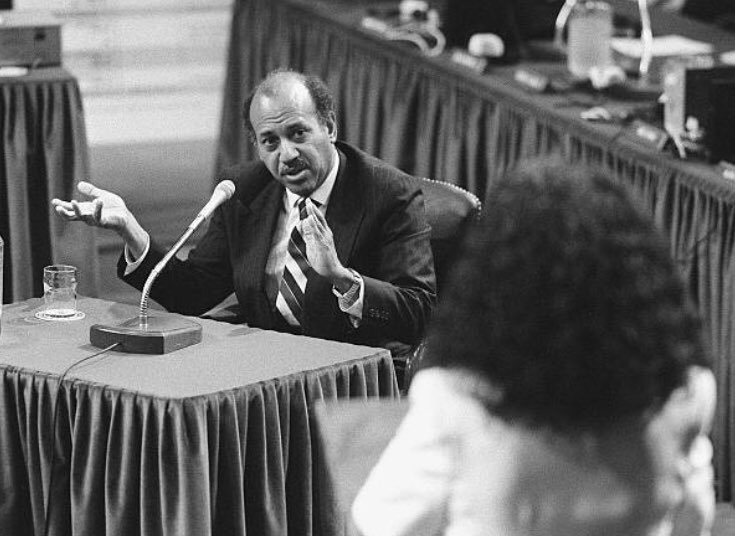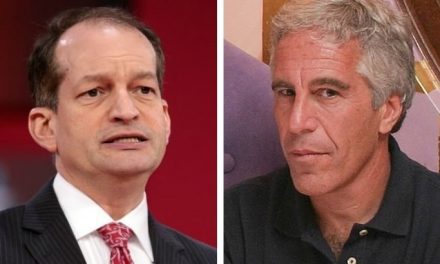Rep. Alcee Hastings, who has served in Congress since 1993, is the vice-chair of the Democrat-controlled House Rules Committee. He’s also a former District Court federal judge for the Southern District of Florida who was impeached and removed from the bench in 1989. A history of his ordeal is available on the U.S. Senate’s website and it’s instructive as the trial of Donald John Trump approaches.
The short version is that President Jimmy Carter appointed Hastings to the federal bench in 1979. Only two years later, in 1981, the South Florida jurist was arrested for accepting a bribe in return for giving lenient sentences to mobsters Frank and Thomas Romano on 21 counts of racketeering. But Hastings caught a lucky break. His alleged co-conspirator William Borders was convicted but refused to testify against Hastings and the Judge was acquitted.
However, a month after the acquittal, two U.S. District Court judges filed a formal complaint accusing Hastings of fabricating his defense. In 1986, three years later, the 11th U.S. Circuit Court of Appeals, which covers South Florida, made a referral to Congress recommending that Hastings be impeached.
The impeachment process was complicated and controversial. In a 413-3 vote, the House impeached Hastings in 1988. The Senate then created a 12-member special committee to hear evidence in the case. In all, they heard testimony from 55 witnesses. Hastings argued that the Special Committee was unconstitutional and that his case could only be tried in front of the whole Senate. However, the committee didn’t vote on guilt or innocence but rather issued a report to the full Senate. The actual trial lasted a single day and resulted in Hastings being convicted on 11 of 17 articles of impeachment in 1989.
At that point, the then Senate President Pro Tempore, Sen. Robert Byrd of West Virginia, ordered Hastings removed from the bench. Fortunately for Hastings, the Senate did not vote on whether or not to ban him from ever holding another position of honor, trust or profit in the U.S. government, and three years later he won election to Congress, taking his seat in 1993.
In 1992, Hastings used his objection to the Special Committee to appeal his impeachment convinction before the District Court for the District of Columbia, and he initially won. But that ruling was superseded by the Supreme Court’s ruling in the 1993 Nixon v. United States case that the Senate’s impeachment procedures are not reviewable by the judiciary. As for Borders, the convict who declined to testify against Hastings, he was pardoned by President Clinton on his last day in office.
I don’t mention all this to make a “both-sides” argument that Democrats are also capable of corruption or gaming the pardon process. Rather, the Hastings saga is useful for understanding some of the controversies swirling about Trump’s second impeachment.
First, the Nixon case establishes that the Senate has wide leeway to establish the rules for an impeachment trial since the judiciary has no oversight role. Also, note that it was Sen. Robert Byrd who presided over Hastings’ trial and ultimately removed him from the bench. The role fell to Byrd for two reasons. The Constitution provides that the Chief Justice of the Supreme Court shall preside over the impeachment of a president, but only a president. Since Hastings was a judge, the job went to the president of the Senate, which at the time was Vice-President Dan Quayle. However, Quayle wasn’t interested in presiding, so he delegated responsibility to the officer authorized to act in his stead: the longest serving member of the majority, or Senate President Pro Tempore.
Since Donald Trump is no longer the president, this means that his trial will not be conducted by Chief Justice John Roberts but instead Sen. Patrick Leahy of Vermont, the president pro tempore, who was elected three months after President Nixon resigned his office in 1974.
On Monday, the House delivered the articles of impeachment to the president. What comes next is governed by the Senate Rules of Procedure:
III. Upon such articles being presented to the Senate, the Senate shall, at 1 o’clock afternoon of the day (Sunday excepted) following such presentation, or sooner if ordered by the Senate, proceed to the consideration of such articles and shall continue in session from day to day (Sundays excepted) after the trial shall commence (unless otherwise ordered by the Senate) until final judgment shall be rendered, and so much longer as may, in its judgment, be needful.
By mutual agreement between Senate Majority Leader Chuck Schumer of New York and Minority Leader Mitch McConnell of Kentucky, the trial will be delayed until February 8. The delay allows the Senate to work on a COVID-19 pandemic bill and the confirmation of Biden’s cabinet-level appointments, and it allows time for Trump’s lawyers to craft a defense.
As the Hastings impeachment makes clear, the Senate makes the trial rules. It could delegate the matter to a Special Committee which would issue a report to the full Senate. Conversely, they can have no witnesses at all and rely completely on the presentations of the House Managers and Trump’s defense team.
Without Chief Justice Roberts presiding, there’s no input from the judiciary, and scant prospect that the proceeding will be preemptively ruled unconstitutional on the grounds that an ex-president cannot be impeached.
As things stand, the House Rules of Procedure flatly states that impeachment of former officials is permissible, and Leahy won’t disagree:
The House and Senate have the power to impeach and try an accused official who has resigned…As a practical matter, however, the resignation of an official about to be impeached generally puts an end to impeachment proceedings because the primary objective–removal from office–has been accomplished.
The final lesson from the Hastings impeachment is that if the Senate convicts and fails to forbid future officeholding, it may regret that decision. Whether Hastings has redeemed himself during his 28-year congressional career is open to interpretation. In 2014, the Treasury Department paid out a $222,000 sexual harassment settlement to a member of Hastings’ congressional staff. In 2020, a House Ethics Committee investigation into Hastings’ possibly inappropriate relationship with a staffer was dropped because the two got married.
The only way to guarantee Trump doesn’t make a political comeback is to bar him from holding future office. Inciting an insurrection warrants that verdict, whether the Congress delivers it or not.







